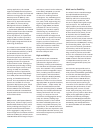
Alcatel-Lucent 7750 SR | Data Sheet 5
VPLS. The integrated solution com-
bines the scalability benefits of PBB
and the resiliency, traffic engineering
and convergence benefits of VPLS. The
integration of PBB with VPLS enables
operators to leverage their existing
metro Ethernet infrastructure, pro-
viding interoperability between native
Ethernet and VPLS, while expanding
their service to reach national or
international markets. Leveraging
the programmability of FP technology,
PBB was introduced through software,
without any hardware upgrades. The
industry-leading standards-based flood
containment and tiered resiliency
mechanisms for PBB-VPLS provide
improved reliability and flexibility for
end-to-end Ethernet services.
Leadership in mobile IP
network transformation
The Alcatel-Lucent 7750 SR is also fully
equipped to enable mobile network
transformation and convergence. By
integrating TDM, ATM and Ethernet
traffic, the 7750 SR simplifies and
scales CDMA/EVDO and GSM/UMTS/
HSPA networks, enabling evolution to
an efficient all-IP transport network
and removing barriers to offering
new services. To handle bandwidth-
intensive IP data services, Multilink
Point-to-Point Protocol (MLPPP), ATM
Inverse Multiplexing over ATM (IMA)
and multichassis automatic protection
switching (MC-APS) are supported.
Circuit Emulation Service (CES)
standards, either CES over Packet
(CESoP) or Structure-Agnostic Trans-
port over Packet (SAToP), enable the
backhauling of 2G and 3G network
traffic over IP/MPLS or Ethernet. The
7750 SR delivers advanced synchroniza-
tion techniques and allows flexible
options for transport of timing over
packet networks (line timing, BITS,
adaptive and differential clock
recovery, Synchronous Ethernet).
CDMA/EV-DO operators can facilitate
network provisioning and operation
with configurable QoS profiles for
multi-class MLPPP. The use of multi-
class MLPPP enables efficient multi-
class traffic convergence and extends
the life of costly backhaul links.
Also, the Alcatel-Lucent 7750 SR
safeguards investments by offering
the ability to seamlessly and smoothly
transition to 4G (WiMAX, LTE). Using
the 7750 SR, mobile operators can
allow the seamless coexistence of 2G
and 3G mobile technologies with
reliable and efficient bearer and
control transport of 4G mobile traffic.
Unmatched multi-service density
With highly-flexible, modular physical
network interface options, the Alcatel-
Lucent 7750 SR provides industry-
leading Ethernet density along with
a full breadth of interface types, inclu-
ding packet over SONET/SDH (PoS),
circuit emulation services (CES) and
ATM. Portable across platforms, MDAs,
IOMs and IMMs provide modularity
and configuration flexibility.
MDAs are hot-swappable, half-slot
adapters that insert into a full-slot
7750 SR IOM. Supporting up to two
MDAs, the IOM provides fully distrib-
uted forwarding and packet services
and delivers the full complement of
the Alcatel-Lucent SR OS capabilities
for the 7750 SR. The 7750 SR MDAs
deliver comprehensive IEEE 802.3
compliance and in conjunction with
the selected IOM, provide multi-service
support for Layer 2 and Layer 3 IPv4
and IPv6 routed services, IP/MPLS,
Ethernet over MPLS (EoMPLS), VPLS,
and VPWS with a highly personalized
service context. When used with IOM3-
XPs, MDA-XP variants provide 25 Gb/s
(full duplex), boost slot capacity to
50 Gb/s (full duplex) and support
synchronous Ethernet (sync-E) on
optical MDA-XPs. Also, MDAs use
small form factor pluggable (SFP)
optics to provide greater flexibility by
populating MDAs with the required
optics on a per-port basis.
For true multi-service, multi-encapsula-
tion interface flexibility, the Any Service
Any Port (ASAP) Media Dependent
Adapter (MDA) converges diverse
interfaces and protocols onto a
common MDA for the 7750 SR. Each
ASAP MDA port can be independently
configured to deliver clear channel or
channelized connections — supporting
from DS0 up to the maximum port
speed, with increments through DS3/
E3, OC-3/STM-1 and OC-12/STM-4.
Each port or channel can be config-
ured with any combination of Layer 2
and Layer 3 services, and each port or
channel’s upper layer encapsulation
can be flexibly configured to support
Ethernet, Frame Relay, Point-to-Point
Protocol (PPP), Packet over SONET
(POS), Asynchronous Transfer Mode
(ATM), and High-Level Data Link
Control (HDLC). Additionally, the ASAP
MDA supports channel bundling using
Multi-Link PPP (MLPPP) and ATM
Inverse Multiplexing over ATM (IMA)
over multiple DS1/E1 links, enabling
service operators to offer very granu-
lar bandwidth services and a broader
range of tiered offerings.
Designed for specialized, very dense
Ethernet routing applications requir-
ing high density and high throughput,
Integrated Media Modules (IMMs)
combine a fully distributed forwarding
and packet processing services engine
with fixed 10/100, gigabit, and 10 gigabit
Ethernet ports. With full support for
IP routing and multiprotocol label
switching (MPLS), 7750 SR IMMs
support the full range of layer 2
and IPv4/IPv6-based layer 3 services,
including virtual private LAN services
(VPLS), enhanced Internet, and IP
virtual private network (IP VPN)
services. Leveraging FP2 technology,
the IMM delivers 50 Gb/s (full duplex)
slot capacity, features comprehensive
IEEE 802.3 compliance, sync-E on
optical modules, and it supports a
broad range of copper and pluggable
optical interfaces. Using the IMM, the
7750 SR delivers industry-leading
densities, with up to 80 10GigE and
480 GigE ports per chassis. This trans-
lates to a density of 240 10GigE and
1,440 GigE ports in a seven-foot rack.
Service-aware OAM
With a purpose-built, service-aware
framework, the Alcatel-Lucent 7750 SR
offers unprecedented simplification
and cost reduction of network oper-
ations through rapid diagnosis of














